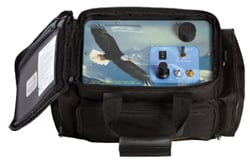Interpulmonary Percussive Ventilation (IPV)
Jump to:
(IPV)
What is IPV?
IPV helps open your airways and move mucus in your airways. It does it with small, fast bursts of air. You will notice a mist. This helps to loosen the mucus. This makes it easier to cough or suction the mucus out of your airways.
When might IPV be needed? 
If you have:
- Cystic Fibrosis
- Bronchiectasis, this is when there are issues with the large airways
- Smoke Inhalation
- Atelectasis, this is when a small area of the lung collapses.
- Aspiration, this is when fluid or food is inhaled in to the lungs
How does an IPV work?
- An IPV treatment can be done with just saline. You can also give some nebulizer medicines with it.
- The speed of busts of air helps to loosen mucus and move it.
- Faster bursts loosens mucus.
- Slower bursts move mucus up and out of the lungs. - When your machine is delivered, the home care company will set it up. They will teach you how to use it.
- Your doctor will tell you to give nebulizer medicines, just saline, or both. They will tell you:
- how and when to do the treatments.
- length of treatment.
Special Notes:
- If you have a tracheostomy tube, you will get an adapter to use with you trach.
- Make sure the air or water in your trach tube cuff is removed before starting the treatment.
- After the treatment replace the air or water in the trach tube cuff. - Place the mask over the face and nose. Hold the mask firmly. Keep the cheeks tight.
- Huff cough or suction after your treatment to get the mucus out.
- If you have a sick plan, your doctor will tell you how to change your treatments.



